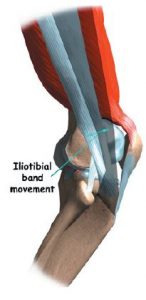Sport Rehabilitation and Physiotherapy forv Iliotibial Band (ITB) Syndrome
What is Iliotibial Band (ITB) Syndrome?
Pain on the outside of the knee caused by inflammation of the thick band of connective tissue which originates near the pelvis, travels down the outside of the leg and inserts below the knee cap.
What Causes Iliotibial Band (ITB) Syndrome?
Excessive friction due to the band sliding over the bony contours of the knee (see picture). It is most common in repetitive activities such as running and cycling. Poor foot posture (pronation) may cause this as the arch of the foot flattens and the leg twists increasing the stress on the band. Other contributing factors are pre-existing ITB tightness and muscular weakness around the knee and hip, especially in the buttock region.
What are the signs & symptoms of Iliotibial Band (ITB) Syndrome?
Pain during or following repetitive activity with tenderness to touch over the outside of the knee. This may start as a diffuse ache but progress to a sharp pain and there may be some swelling. If severe it may hurt if sitting for extended periods with a bent knee. A special test called “Obers test” detects tightness of the ITB. Occasionally it can produce symptoms around the hip as the band also crosses this joint.
What will treatment consist of for Iliotibial Band (ITB) Syndrome?
Massage – Encompassing a variety of techniques with sufficient pressure through the superficial tissue to reach the deep lying structures. It is used to increase blood flow, decrease swelling, reduce muscle spasm and promote normal tissue repair.
Mobilisation – A manual technique where the joint and soft tissues are gently moved by the therapist to restore normal range, lubricate tissues and relieve pain.
Ultrasonic Therapy – Transmits sound waves through the tissues stimulating the body’s chemical reactions and therefore healing process, just as shaking a test tube in the laboratory speeds up a chemical reaction. It reduces tissue spasm, accelerates healing and results in pain relief.
Interferential Therapy – Introduces a small electrical current into the tissues and can be used at varying frequencies for differing treatment effects. E.g. pain relief, muscle or nerve stimulation, promoting blood flow and reducing inflammation.
What other treatments could be used for Iliotibial Band (ITB) Syndrome?
Acupuncture – An oriental technique of introducing needles into the skin to increase or decrease energy flow to promote pain relief and healing.
Taping/Strapping – May be used if thought necessary to restrict abnormal movement and prevent further damage.
What can you do yourself to help Iliotibial Band (ITB) Syndrome?
Active Rest – Keep active but avoid activities that aggravate your condition i.e. any activity that places repetitive strain on your knee, such as running or cycling.
Apply an ice pack – For a maximum of 20 minutes. A bag of frozen peas wrapped in a damp cloth works well because it moulds to the shape of the tissues. Ensure that you do not apply ice directly to the skin as this can cause an ice burn.
Exercise programme – This is the most important part of the rehabilitation. Your therapist will instruct you as to which exercises to begin with, when to add the others, as well as how to progress the exercises.
Medication – Ask your GP or Pharmacist for advice on the best medication for your condition.
Podiatry – An analysis of the foot mechanics and structure during walking or running and correction as appropriate.
What if physical therapy does not help or resolve Iliotibial Band (ITB) Syndrome?
It is very rare that treatment does not resolve this condition. In these cases we will refer you on for further investigation.
If you think you may have this condition we would love the opportunity to show you our expertise in the treatment and management of this condition so – Please click here for details of how to contact us to book an appointment
If you are unsure whether you have this condition or you would just like to speak to somebody then please get in touch here or call 0161 745 7551 or 0151 515 2323

